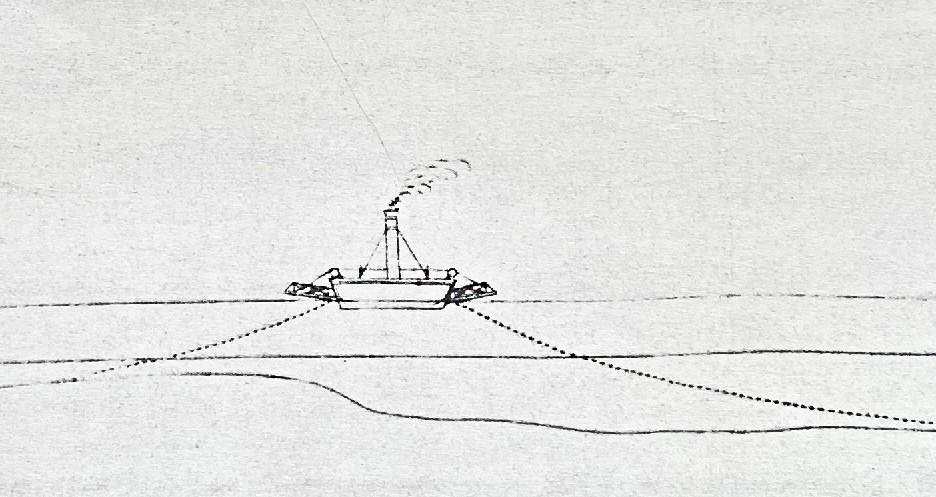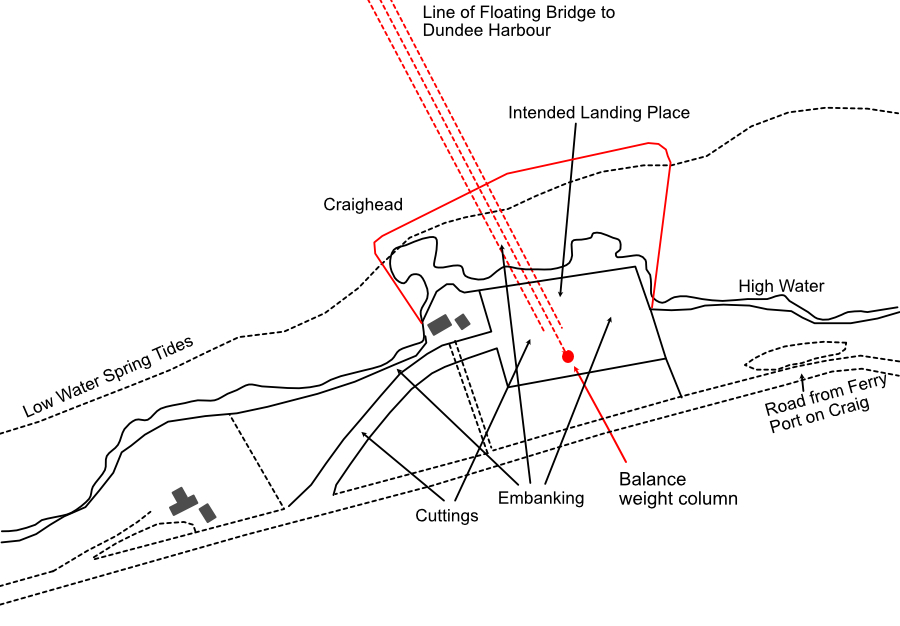The previous post mentioned the floating bridge or chain ferry which was included in some railway plans as a means of crossing the river. But it wasn’t primarily a railway crossing – it was intended to replace or augment the existing steam ferry boats.1

To operate the ferry, chains would be laid across the river bed from Fife to Dundee. The steam ferry boat would use its engines to wind itself along the chains rather than drive a paddle wheel. The chains would need a counterbalance at each end. The boat would be able to load and unload via its ramps which only needed a flat landing place rather than an expensive pier. The power required by the boat was calculated to be one tenth of that used to power its paddle wheels.
The idea of a floating bridge on the Tay was first put forward as early as March 1834.2 James Meadows Rendel, who had successfully installed such a ‘bridge’ at Saltash, proposed to install and operate one here. The proposal was received coolly in Dundee, but the Ferry Trustees were soon to be overtaken by the march of progress.
Over the next few years several influences came together: competing railway companies were considering how to cross the Tay; the ferry operation was increasingly busy but was hampered by the sandbank in the middle of the river; the Harbour Trust (at that time a different organisation from the Ferry Trustees) were looking for extra low-water facilities; and the Ferry Trustees’ debts were not being repaid.
Above all, it was the finances of the Ferry Trustees that were to force the issue. Set up in 1819 to improve the ferry, the Trust had built piers, provided new boats and created a fairly efficient system. Their present annual income from tolls was £4900 with running costs of £3470. Unfortunately, the improvements had come at a cost: they were £46000 in debt. Of this, £22850 was public money, £8828 was owed to the Dundee Banking Co, £1791 to Mr Stewart of St Fort, and £500 to the former innkeeper and tacksmen at Woodhaven, one now deceased, as compensation for their loss of business when the ferry moved to Newport. All amounts are ‘plus interest’ or ‘plus a considerable arrear of interest’.3 There was comment at the time that the public were not aware of the amount of debt, since only income and expenditure accounts were publicly presented.4
The Exchequer Loan Commissioners (or the Public Works Loan Commissioners – the public source of funding) were obviously so concerned that they had unilaterally taken control of the ferry and intended to operate it or take such actions as would see a return of their investment.
They moved quickly and asked for a report – from James Rendel.
So in September 1842 Mr Rendel again proposed his floating bridge.5 This time he had some powerful backing. He didn’t foresee any problems with the tides or the amount of traffic. However, because of the sandbank in the middle of the river, the existing terminal at Newport pier would not be usable. Instead it was proposed to move the terminal to Craighead (where now the road bridge makes its Fife landfall). The Dundee terminal would be at the Beacon Rock (the southernmost of the 2 rocks off Dundee docks just east of the road bridge) and this would need to be connected to the main harbour. The Princess Royal (existing ferry boat) would only need 1 of her engines to operate the winding gear. Running costs would be £1700 with 2 crossings per hour. There would be no need to increase charges, the number of crossings could be increased, and the debt could be repaid.
Dundee Bailie Adam Symon (who incidentally had lived at Broadhaugh) championed Rendel’s cause but many of the Ferry Trustees, in particular Mr Berry, were strongly opposed to the idea.6
When the plans for Parlaiment were made, the Dundee terminal had changed to be at Craig Pier.7 The Fife terminal remained at Craighead – it gave a shorter crossing, avoided the sandbanks and was ideally placed for a railway terminal.
The Parliamentary bill was rapidly passed.8 The Ferry Trustees’ protestations came to nothing. The Act was overwhelmingly about finance – making sure that the debt would be repaid. The floating bridge seemed certain to go ahead and the operation was given 5 years to be up and running.9
The railway companies were initially overjoyed10 with the idea (although they continually referred to Beacon Rock as being the Dundee terminus). As time passed, they became lukewarm.
But …
This floating bridge came to nothing. The Dundee Banking Company bought the outstanding Tay Ferries loan from the Public Works Loan Commissioners11 thereby taking out their interest and drive in the project. The Bank then sold the debt to the Scottish Central Railway Company, whose plans for a railway failed to materialise. Instead the Edinburgh & Northern Railway (who had tried to buy out the Public Works Loan Commissioners but were thwarted by the Bank), out of what appears to be a fit of pique, built their harbour at Tayport and operated their own floating bridges, designed by Thomas Bouch, from there to Broughty Ferry. And very successful they were too.
———————–

This plan12 , which goes from what is now the Tay Road Bridge landfall on the right to almost the foot of James Street on the left, shows the intended landing area at Craighead. The 2 blocks in the centre are Craighead Cottage and a small cottage to the east of it; the 2 blocks towards the left are Kempstane (now the site of 81 Tay Street). The landing place is now the site of the nursing home and Taygrove – 111, 113, 115 Tay Street.
———————–
And what of James Rendel? He had worked on the Tay before – surveying the new landing piers for the Tay Ferry as an assistant to Thomas Telford.13 His floating bridges were used at Dartmouth, Saltash, Torpoint, Southampton & Portsmouth. But he was better remembered as a dock engineer (Birkenhead & Grimsby) than for his ferries. He died in London in 1856.14
Sources:
- Fifeshire Journal, 3 Nov 1842, p1 (all newspapers available at British Newspaper Archive)
- Caledonian Mercury, 17 Mar 1834, p3
- Fife Herald, 1 Sep 1842, p4; and Tay Crossings Act, 1843, 6 & 7 Vic. c. lxxxiv
- Fife Herald, 5 May 1842, p1
- Fife Herald, 1 Sep 1842, p4
- Fife Herald, 6 Apr 1843, p3; Fifeshire Journal, 6 Apr 1843, p2; Fife Herald, 18 May 1843, p5
- Plan and sections of proposed floating bridge across River Tay from Craighead to Craig Harbour, Dundee at the National Records of Scotland, ref. RHP34329.
- Fifeshire Journal, 3 Aug 1843, p2
- Tay Crossings Act, 1843, 6 & 7 Vic. c. lxxxiv
- Fife Herald, 23 Sep 1843, p3
- Dundee, Perth & Cupar Advertiser, 16 Sep 1845, p2
- Drawing of ferry boat, and plan of Craighead, from Plan and sections of proposed floating bridge across River Tay from Craighead to Craig Harbour, Dundee at the National Records of Scotland, ref. RHP34329.
- Rendel’s Floating Bridges, Alan Kittridge, 2008. Useful for background, but the section on the Tay has errors (the ferry was approved by Parliament, it just was never built).
- Grace’s Guide to British Industrial History, https://www.gracesguide.co.uk/James_Meadows_Rendel; and Rendel’s Floating Bridges, Alan Kittridge, 2008.
